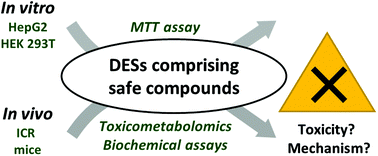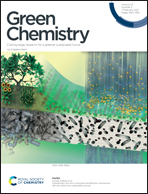Toxico-metabolomics study of a deep eutectic solvent comprising choline chloride and urea suggests in vivo toxicity involving oxidative stress and ammonia stress†
Abstract
Deep eutectic solvents (DESs) comprising safe constituents are generally considered green and nontoxic without careful assessment. Here, eight different DESs were prepared from edible components including choline chloride (ChCl) as the hydrogen bond acceptor and were tested for in vitro cytotoxicity. Both DESs and simple aqueous mixtures of DES constituents showed different cytotoxicities depending on the cell line and often had elevated toxicities compared to their individual constituents. Moreover, several DESs were more cytotoxic than their aqueous mixtures. An in vivo toxico-metabolomic study was applied for the first time to CU (1 : 2), a commonly used DES, comprising ChCl and urea at 1 : 2 molar ratio. Mice were acutely exposed to CU (1 : 2) (1.5 g kg−1) via oral administration; its effects were investigated in comparison with those of ChCl, urea, an aqueous mixture of ChCl and urea, and saline. Metabolomic analyses of the liver, kidney, and serum revealed disturbances in the metabolism of glutathione, nicotinamide, taurine, pyruvate, lactate, and lysophosphatidylcholines, suggesting that CU (1 : 2) treatment induced oxidative stress. The levels of branched-chain amino acids and taurocholic acid were perturbed, suggesting that the CU (1 : 2)-treated mice underwent ammonia stress and intestinal dysbiosis, respectively. The DES-induced oxidative stress was confirmed by biochemical assays to measure superoxide dismutase activity, catalase activity, the ratio of reduced to oxidized glutathione, and malondialdehyde levels. Ammonia stress was confirmed because the blood of the DES-treated mice had significantly elevated ammonia levels. Ammonia assay revealed that ammonia could be produced from ChCl and urea during the DES preparation both with and without heat, and ammonia was also detected in the DESs comprising ChCl and organic acids. Thus, ChCl-based DESs, especially those containing urea should be used with caution because they may contain ammonia, which is putatively responsible for toxic effects of DESs different from simple mixtures. The in vitro and in vivo studies together suggest that ChCl-based DESs may not be considered as pure, safe mixtures even if they consist of safe compounds.



 Please wait while we load your content...
Please wait while we load your content...